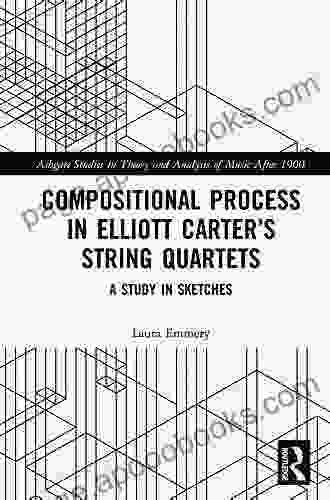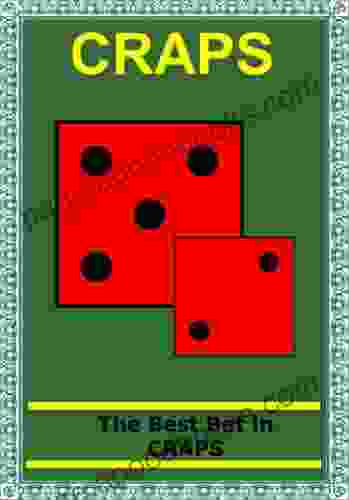Delving into the Compositional Process of Elliott Carter's String Quartets: A Journey of Innovation and Complexity

:
Elliott Carter, a towering figure in 20th-century music, crafted a legacy of groundbreaking works characterized by intricate compositional techniques and a ceaseless pursuit of innovation. Among his most significant contributions are his five string quartets, composed over a span of nearly four decades. These quartets, each a masterpiece in its own right, serve as a testament to Carter's masterful handling of harmony, rhythm, and form, pushing the boundaries of musical expression. In this article, we embark on an in-depth exploration of Carter's compositional process, uncovering the intricate tapestry of musical ideas that shaped these extraordinary works.
5 out of 5
| Language | : | English |
| File size | : | 34686 KB |
| Print length | : | 268 pages |
| Screen Reader | : | Supported |
The Early Quartets: Experimentation with Serialism:
Carter's early quartets, the String Quartet No. 1 (1951) and String Quartet No. 2 (1959),bear the hallmarks of his fascination with serialism, a technique that involves organizing musical elements—such as pitch, duration, and dynamics—in a predetermined Free Download. In the String Quartet No. 1, Carter employs a 12-tone row as the basis for both melodic and harmonic structures, creating a sense of unity and cohesion. However, he also introduces elements of chance, allowing certain aspects of the music to be determined by dice rolls. This fusion of determinacy and indeterminacy becomes a hallmark of Carter's approach to composition.
In the String Quartet No. 2, Carter further explores serialism, utilizing a more complex 12-tone row and employing a technique called "metric modulation," in which the tempo changes abruptly, creating a sense of rhythmic instability. The result is a work of intense rhythmic and harmonic complexity that challenges traditional notions of musical time and structure.
Expanding Horizons: Polyrhythm and Polytonality:
With his String Quartet No. 3 (1971),Carter took a significant departure from the strictures of serialism, embracing a more eclectic approach to composition. This quartet incorporates polyrhythm, the use of contrasting rhythms simultaneously, and polytonality, the use of multiple keys at the same time. The result is a work of extraordinary rhythmic and harmonic richness, creating a sense of dynamic tension and release.
Carter's exploration of polyrhythm and polytonality continues in his String Quartet No. 4 (1985),a virtuosic and demanding work that showcases his masterful handling of these techniques. The quartet is characterized by an intricate interplay of different rhythmic patterns, creating a sense of rhythmic complexity that bFree Downloads on the chaotic. The harmonies, too, are constantly shifting, creating a sense of harmonic instability and uncertainty.
The Summation: A Culmination of Lifetime Experiences:
Carter's final string quartet, String Quartet No. 5 (1995),stands as a culmination of his lifetime of compositional experiences. The work draws on elements from all of his previous quartets, combining the rhythmic complexity of the third and fourth quartets with the harmonic richness of the second quartet. However, there is also a sense of newfound maturity and serenity in this final work, as if Carter were reflecting on his long and illustrious career.
:
Elliott Carter's string quartets represent a testament to his groundbreaking approach to music, characterized by an insatiable curiosity and a relentless pursuit of innovation. Through his meticulous compositional process, Carter created works that challenge traditional notions of tonality, rhythm, and structure, pushing the boundaries of musical expression. His string quartets stand as enduring monuments to his genius, inspiring generations of composers and musicians alike.
Further Reading:
- Elliott Carter's String Quartets: An by David Schiff
- Elliott Carter by David Schiff
- Elliott Carter: A Centennial Portrait in Letters and Documents edited by Judith Tick
5 out of 5
| Language | : | English |
| File size | : | 34686 KB |
| Print length | : | 268 pages |
| Screen Reader | : | Supported |
Do you want to contribute by writing guest posts on this blog?
Please contact us and send us a resume of previous articles that you have written.
 Book
Book Novel
Novel Page
Page Chapter
Chapter Text
Text Story
Story Genre
Genre Reader
Reader Library
Library Paperback
Paperback E-book
E-book Magazine
Magazine Newspaper
Newspaper Paragraph
Paragraph Sentence
Sentence Bookmark
Bookmark Shelf
Shelf Glossary
Glossary Bibliography
Bibliography Foreword
Foreword Preface
Preface Synopsis
Synopsis Annotation
Annotation Footnote
Footnote Manuscript
Manuscript Scroll
Scroll Codex
Codex Tome
Tome Bestseller
Bestseller Classics
Classics Library card
Library card Narrative
Narrative Biography
Biography Autobiography
Autobiography Memoir
Memoir Reference
Reference Encyclopedia
Encyclopedia Melissa R Wolfe
Melissa R Wolfe Matthew Longo
Matthew Longo Neil Thompson
Neil Thompson Hester Fox
Hester Fox Susan Srikant
Susan Srikant Ron Mcadoo
Ron Mcadoo Susan Helen Ellison
Susan Helen Ellison Michaela Morgan
Michaela Morgan Michele Kaschub
Michele Kaschub Mark Schuller
Mark Schuller Michael Finch
Michael Finch Shirley Collins
Shirley Collins Susan Conners
Susan Conners Melissa Samaroo
Melissa Samaroo Nicki Night
Nicki Night Vladimir Skenderoff
Vladimir Skenderoff Stephon Frazier
Stephon Frazier Mike Dennison
Mike Dennison Maynard Parks
Maynard Parks Natasha Quadlin
Natasha Quadlin
Light bulbAdvertise smarter! Our strategic ad space ensures maximum exposure. Reserve your spot today!

 Terence NelsonCross Stitch Patterns Easter Gnome Basic Tutorial Embroidery Design In Pdf: A...
Terence NelsonCross Stitch Patterns Easter Gnome Basic Tutorial Embroidery Design In Pdf: A...
 Dave SimmonsUnleash the Thrill: Immerse Yourself in the World of John Corey, Joe Ryker,...
Dave SimmonsUnleash the Thrill: Immerse Yourself in the World of John Corey, Joe Ryker,... Brenton CoxFollow ·15.9k
Brenton CoxFollow ·15.9k Jeffery BellFollow ·5.2k
Jeffery BellFollow ·5.2k Owen SimmonsFollow ·16.4k
Owen SimmonsFollow ·16.4k Wesley ReedFollow ·14.5k
Wesley ReedFollow ·14.5k Shannon SimmonsFollow ·10.7k
Shannon SimmonsFollow ·10.7k Ernesto SabatoFollow ·8k
Ernesto SabatoFollow ·8k Jarrett BlairFollow ·14.2k
Jarrett BlairFollow ·14.2k VoltaireFollow ·17.1k
VoltaireFollow ·17.1k

 Ben Hayes
Ben HayesJourney into the Verdant Realm of "Plants vs. Zombies:...
Immerse Yourself in an Epic Battle for...

 Edward Reed
Edward ReedUnveiling the Allure of Modish Crochet Hats Annie...
In the realm of fashion and...

 Jaylen Mitchell
Jaylen MitchellHalf Moon Bay: An Unforgettable Adventure Awaits in Aj...
Prepare yourself...

 Dan Brown
Dan BrownUnleash the Plant-Powered Apocalypse: Dive into Paul...
Prepare yourself for an epic showdown where...

 Efrain Powell
Efrain PowellStolen Summer: Nora Sommer's Enthralling Caribbean...
Escape to a World of...

 Steven Hayes
Steven HayesPlants vs. Zombies: Lawnmageddon - The Ultimate Battle...
Prepare for the ultimate battle between plants...
5 out of 5
| Language | : | English |
| File size | : | 34686 KB |
| Print length | : | 268 pages |
| Screen Reader | : | Supported |








